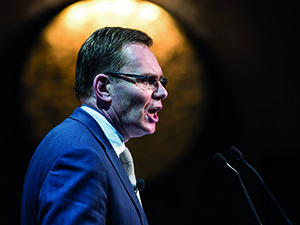
[miningmx.com] – EARLIER this year BHP Billiton was slapped with a fine by the US Securities Exchange Commission (SEC) after it failed to properly monitor a programme under which it paid for dozens of foreign government officials to attend the opening ceremony of the Beijing Olympics in 2008.
Given the other problems with which BHP Billiton has to deal, especially in the current metal price meltdown, that’s no big deal, right? The fine, some $25m (R310m), is like dealing in fractions for a company that hands over up to $10bn (R124bn) in tax to the Australian fiscus every year.
Yet the fact that the fine was actually penance for contravening US anti-bribery laws gives some insight into the super-cycle during the 2000s, when investors flocked to mining shares, CEOs were bullet proof, and the commodity “up-cycle’ was forecast to last decades, not the decade that actually materialised.
The Melbourne-headquartered group was sponsoring the Olympics – an outlay in marketing that would be unimaginable today – but as the Australian Financial Review explained it, Beijing was China’s “coming out’ party.
The world “… stood on the doorstep of tectonic change as China turned to global resources markets to feed the reformation of its domestic economy,’ the newspaper said.
BHP Billiton, buoyant with the opportunity to supply the materials needed to support the growth of China’s middle class, treated 176 government officials and employees of state-owned enterprises to three- to four-day hospitality packages including event tickets, luxury hotel accommodation, meals and business class airfares.
Marius Kloppers, then CEO of BHP Billiton, took a seat at the opening ceremony beside the president of Chinese state-owned alumina producer, Chinalco’s Xiao Yaqing. Even the mines minister of Burundi was invited to attend, despite his country’s civil ructions at the time – no matter – such was the aboundless appetite for commodities that it was perhaps likely that mining firms would have to cast their nets far and wide.
Six years later, and with SEC having concluded its investigation into BHP Billiton’s Beijing excursion, China’s economy had taken on a somewhat different look. It was still growing, but the 14% gross domestic product growth of 2007 – that saw Kloppers seize a seat next to a potential trade partner – had slowed to a shade over 7%, and now may be heading even lower, spreading panic throughout the market.
Perhaps oddly, BHP Billiton then fell afoul of the regulators for another, completely different, reason.
In May, Australia’s senate said the trading behaviour of the group, now led by Andrew Mackenzie, and its rival Rio Tinto, ought to be subject of an inquiry.
The inquiry aimed at proving whether the two companies were deliberating maintaining high iron ore exports, especially to China, even though there was a chronic market over-supply.
Prices for the mineral had ridden the rollercoaster up and down: tripling in the three years from 2008 to $191 per tonne ($/t) only for the price to crash to below $50/t this year.
The view was that the injudicious pursuit of market share, rooted in the ambition that was manifest in the outlay at the Beijing Olympics in 2008, was now hurting the prospects of smaller players and, therefore, constituted unfair trading behaviour.
Whereas everyone was invited to Beijing, the tenor now was that this was the survival of the fittest, or in this case, the largest.
BHP Billiton and Rio Tinto, as well as Brazilian company Vale, control about 78% of the world iron ore market. Based on the comments of its executives before the inquiry was mooted, they were seemingly intent on increasing their grip over supply.
The Australian firms alone said they expected to increase market share to 70% by 2020, equal to some 900m tons following aggressive expansions.
This was despite reports that demand was falling, although in absolute numbers, it was still high. Citigroup estimated that iron ore demand would fall to 982 million tonnes in 2025, from 1.18 billion tonnes (bt) in 2020. Global demand for seaborne iron ore, meanwhile, would drop to 1.57bt from 1.68bt over the same period.
Mackenzie came out swinging, however.
He argued that stemming production from BHP Billiton would seriously undermine Australia’s commitment to free trade and send “the wrong signals’ to the company’s customers – a view that won the support of both Australia’s Trade and Investment Minister Andrew Robb and Industry Minister Ian MacFarlane, and even threatened to split Australian Prime Minister’s Tony Abbott’s cabinet.
These events serve to show the cyclical nature of the commodities market.
Take Western Australia, for instance, the hub of Australia’s iron ore industry. Whereas it was once placed by Time magazine among the most valuable real estate in the world, it was more recently the grateful recipient of a A$500m cash payout by the federal government after it complained about the impact of falling mining royalties and GST revenue.
One important mining sector participant who didn’t side with BHP Billiton’s Mackenzie, however, was his opposite number at Swiss-headquartered mining and trading group, Glencore’s Ivan Glasenberg.
Glasenberg has a special place in his heart for his diversified mining rivals whom he blames for corporate decadence from which he was publicly absent – as Glencore only listed in 2011 – gallingly for him, just as the commodity price party was ending.
Speaking at the Bank of America Merrill Lynch conference in Barcelona in May, Glasenberg ripped into BHP Billiton and Rio Tinto’s unstinting iron ore supply to China, saying that it was short-sighted and damaging. “Oversupply of markets regardless of demand is damaging the credibility of the industry,’ he said.
Mackenzie has since acknowledged that metal oversupply would continue to hurt the markets for the foreseeable future.
“Incremental supply, induced periods of higher prices, will take longer to absorb and this means over-supply may persist for some time,’ he told a gathering of sector executives and Australian lawmakers in June.
Even Rio Tinto CEO, Sam Walsh, has said that the company didn’t plan on pumping excessive amounts of fresh capital into iron ore expansions.
“We will, of course, invest to ensure the integrity of the Pilbara blend [iron ore quality from Western Australia], but do not anticipate capital investment in further volume at this time,’ he said.
Nonetheless, establishing market share by knocking out smaller companies constitutes a form of positioning for the majors for when the markets eventually revive – a likelihood to which Rio Tinto Chairman, Jac Nasser, referred at the company’s annual general meeting in May. “Let us keep in perspective that across the globe, 70 million people each year are entering the middle class,’ he said.
“The Chinese economy is almost 25 times the size it was 25 years ago, and over the next decade 170 million rural Chinese will move to an urban environment. The fortunes of the mining industry have always been linked to increasing development and prosperity.
“And this will remain the case, regardless of short-term dynamics,’ he said.
Said PwC in its annual mining survey, Mine which analyses the performance of the world’s top 40 mining companies as measured by market capitalisation: “Major iron ore producers are still expecting to post healthy margins if commodity prices remain low, due largely to the quality of their projects and their focus on operational cuts that are helping to improve margins.
“But smaller players will continue to face difficulties. Some companies in Australia are already up against the wall, while some iron ore mines in China have reportedly closed.’
SLUGGING IT OUT
THE short-term effects of the oversupplied iron ore market don’t make for pleasant reading, however. Goldman Sachs forecast that iron ore prices would trend down from $52/t in 2015 to as low as $40/t in 2017.
“Steel production and apparent demand in China are negative year-on-year as a shift away from investment-led infrastructure spending has reduced demand, which, combined with a focus on reducing air pollution, has seen apparent domestic demand for steel down 6.2% year-on-year through to end March 2015,’ said Goldman Sachs.
This would have severe implications for investors who tend to live in here and now.
Companies exposed to the iron ore market would not be able to cover their dividends from free cash flow which, in turn, implied the premiums at which they are trading were unwarranted.
As for the remainder of the iron ore supply industry – those vying for the remaining 20% to 30% of market share – they were likely to be knocked out in a game of “survival of the fittest’, the banker said.
“With limited production cuts to date from high-cost Chinese iron ore miners and no changes to tier 1 producer’s pursuit for scale and cost leadership, we believe that the burden of balancing the market will fall on tier 2 producers,’ said Goldman Sachs, explaining that companies with lower quality assets were the ones most vulnerable to the downturn.
“Our commodities team estimates that about 10% of tier 2 production capacity must be displaced each year until 2018 and iron ore prices must remain below the marginal production cost for the remainder of our forecast period,’ it said.
The recent efforts by BHP Billiton, Vale and even Fortescue Metals to stem iron ore production has left some analysts unmoved that market difficulties are far from over.
Investec Securities analyst Hunter Hillcoat said that cutbacks were really motivated to pressure to reduce capital rather than any authentic concern the iron ore market might be flooded.
“The market has reacted positively to recent communications from iron ore producers, interpreting such actions as a disciplined supply response from key market participants,’ he said.
“We would argue otherwise, noting that all growth plans remain firmly on track and that proposed production changes are cosmetic and will have little to no immediate impact on continuing oversupply in the seaborne iron ore market,’ he added.
Production cuts – even if it was for reasons of prudent internal capital allocation – would not stimulate iron ore prices in the future, Hillcoat argued. “We expect iron ore to recommence its downward path, with prices to average $52/t in 2015,’ he said, a forecast that chimes with Goldman Sachs’ view on the market.
Rio Tinto’s Nasser is surely correct that on a fundamental basis, the commodity market’s next supply deficit is being written today – as X2 Resources CEO Mick Davis described it last year – but, in the short term, mining companies are slugging it out.











